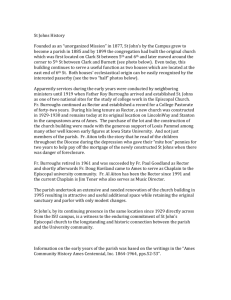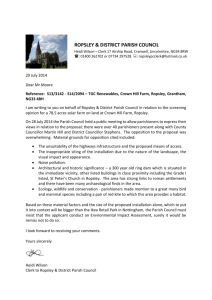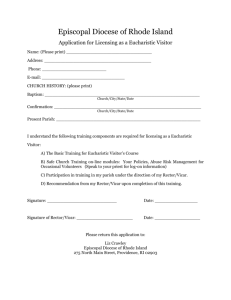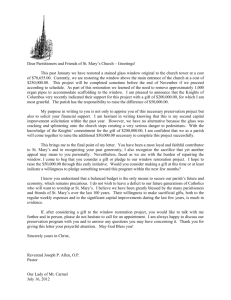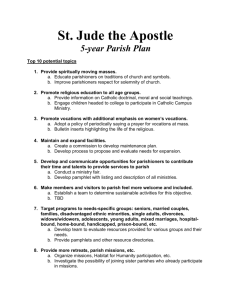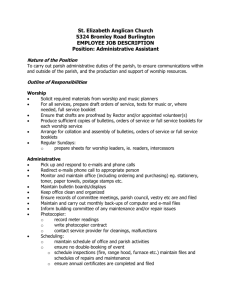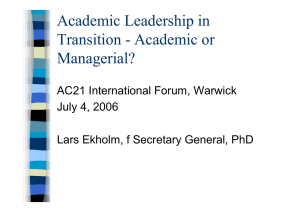A history of St. Nicholas' Church Fundenhall
advertisement
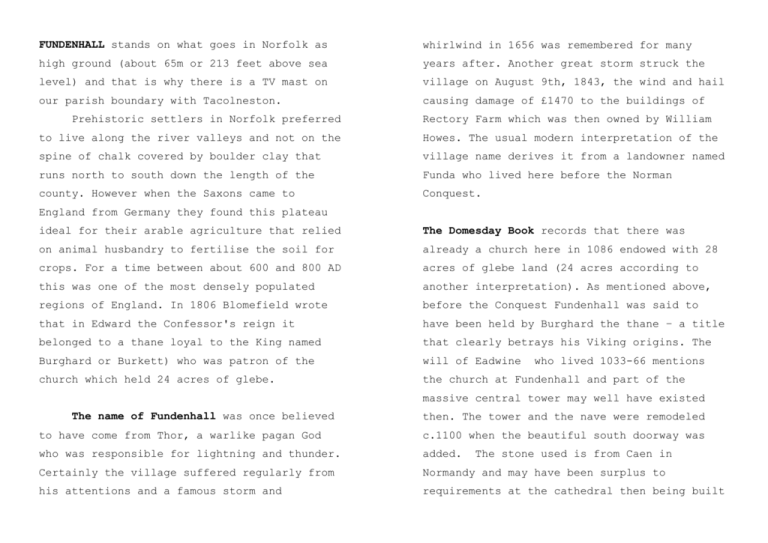
FUNDENHALL stands on what goes in Norfolk as
whirlwind in 1656 was remembered for many
high ground (about 65m or 213 feet above sea
years after. Another great storm struck the
level) and that is why there is a TV mast on
village on August 9th, 1843, the wind and hail
our parish boundary with Tacolneston.
causing damage of £1470 to the buildings of
Prehistoric settlers in Norfolk preferred
Rectory Farm which was then owned by William
to live along the river valleys and not on the
Howes. The usual modern interpretation of the
spine of chalk covered by boulder clay that
village name derives it from a landowner named
runs north to south down the length of the
Funda who lived here before the Norman
county. However when the Saxons came to
Conquest.
England from Germany they found this plateau
ideal for their arable agriculture that relied
The Domesday Book records that there was
on animal husbandry to fertilise the soil for
already a church here in 1086 endowed with 28
crops. For a time between about 600 and 800 AD
acres of glebe land (24 acres according to
this was one of the most densely populated
another interpretation). As mentioned above,
regions of England. In 1806 Blomefield wrote
before the Conquest Fundenhall was said to
that in Edward the Confessor's reign it
have been held by Burghard the thane – a title
belonged to a thane loyal to the King named
that clearly betrays his Viking origins. The
Burghard or Burkett) who was patron of the
will of Eadwine
church which held 24 acres of glebe.
the church at Fundenhall and part of the
who lived 1033-66 mentions
massive central tower may well have existed
The name of Fundenhall was once believed
then. The tower and the nave were remodeled
to have come from Thor, a warlike pagan God
c.1100 when the beautiful south doorway was
who was responsible for lightning and thunder.
added.
Certainly the village suffered regularly from
Normandy and may have been surplus to
his attentions and a famous storm and
requirements at the cathedral then being built
The stone used is from Caen in
at Norwich. One can imagine a gang of rogue
The Norman south door
masons with a cartload of fine stone stopping
off at Fundenhall on the way south and
Fundenhall must have flourished as by the 13th
offering to provide a handsome new entry into
century the endowment of glebe land had grown
the church at a knock-down price.
to 40 acres and the rector resided in a house
that went with the living. However out of this
William the Conqueror granted much of Norfolk
and other income he had to maintain the whole
including the manor of Fundenhall to Ralph
of the church. This was an unusual arrangement
Guader, a Saxon noble who had betrayed King
as in most villages the rector only had to
Harold to join William shortly before the
look after the chancel, the parish taking care
Battle of Hastings. In 1075 Ralph was outlawed
of the remainder of the building. It brought
by the king who discovered that he had also
friction between villagers and their priest
attempted to betray him. Ralph’s lands were
and twice in the 13th century rectors were
confiscated and given to a Norman baron, Roger
brought before the Consistory Court to be
Bigod, who resided at Bungay Castle. Roger
reminded of their responsibilities. One of
Bigod as Lord of the Manor was responsible for
these hearings probably resulted in the
appointing a rector for St Nicholas' church at
chancel being rebuilt c.1250.
Fundenhall. A rector enjoyed a more privileged
In 1258 the Manor of Fundenhall was held
position than a vicar receiving the full
by a descendant of Roger Bigod, Sir
benefit of tithes and endowments owed to the
Bartholomew de Creke, and on his death in that
church whereas a vicar was dependent on the
year his widow founded a convent of
goodwill of the holder of the benefice for a
Augustinian nuns to his memory. It was
proportion of the income of the parish. Later
established at Flixton near Bungay and the
the Bigods, by then earls of Norfolk, moved to
manor of Fundenhall was transferred to the
Framlingham and built a splendid castle there.
nuns so that they could use its revenues, They
also had the right to appoint rectors to the
the vil In 1502 Fundenhall found another
parish.
wealthy patron in John Burgeys (or Burges) who
paid for the remarkable rood loft to be built
In 1347, just two years before the Black
across the east end of the nave. Villagers
Death, Bishop Bateman rescued the declining
must have been dumbstruck when they first set
finances of the nuns by making over the entire
eyes on it, spectacularly painted and gilded
income from the tithes and endowments of the
with an enormous crucifixion scene at the
parish to them, downgrading the living so that
centre. Beneath it was a shield painted with
a chaplain, paid a meagre stipend by the
the arms of the East Angles. On each side
convent, looked after the spiritual needs of
there was further elaborate decoration - the
the inhabitants. This unsatisfactory
letter `P' and cross keys represented St Peter
arrangement was to continue for almost 300
while a Catherine Wheel with gold key, crown
years and accounts for Fundenhall church not
and mitre were the arms of Flixton nunnery.
being rebuilt in later medieval times.
The letters 'SN' in gold lettering stood for
Neighbouring villages - Tacolneston,
St Nicholas.
Ashwellthorpe and Bunwell for example - had
the tower staircase to give access to the
wealthy patrons willing to finance fine new
walkway on top, necessary for lighting the
churches in the expectation of heavenly
numerous candles that illuminated the figures
reward. Fundenhall, in contrast, was dependent
and painted panels. Part of the screen
on a distant and impoverished convent and its
survives despite the Victorian restoration of
church remained largely unaltered with the
the church that took place at a time when the
exception of the tower. This was heightened in
building was again threatened by terminal
1420 or thereabouts with the addition of an
decay.
upper stage paid for by William Danyell, a
wealthy Norwich merchant who had been born in
A doorway was cut through from
One of the most interesting features of the
church, and one of the earliest, is the
sundial ('horary') that can be found on the
west corner of the south wall. The hourly
divisions were scratched into the limestone
quoin probably in the thirteenth century.
Presumably the priest tolled a bell for the
parishioners to get to church in time for
service but how did they know where to scratch
the lines?
preaching minister resident amongst us, the ground of which want is
The Dissolution of the monasteries by King
many miles and our Parsonage with the whole living being worth £60
Henry VIII must have given hope to Fundenhall
per annum and in the possession of the Lady Cleer of Cotton in
that it might find itself with a rector again.
Suffolk, shee will not allowe but tenn or twelve pound per annum,
Instead the king passed on its privileges from
and will not suffer a Clergieman to dwell in the Parsonage, by reason
the dissolved convent to lay rectors who could
whereof we have had 40 returnes of Curates in the memory of one
live well off the stipend and still afford to
man, and our curate oft-times dwelling 5, or 6 miles from us and at
find curates to take care of the parish for a
this present we have not a convenient howse for our Minister to
pittance. Neither were they interested in
inhabite in within our Towne……'
the impropriating of our Parsonage or spiritual, which as we were
informed was done in the Reigne of Henry 4th or Henry 5th without
act of Parliament, on this suggestion that our Towne of Fundenhall
was impoverished soe by inundation of water and death of
parishioners that it was not able to maynetayne a minister to serve
the cure, which is most untrue, noe river coming neare our Towne by
spending money to keep the building
weatherproof. By 1640 the parishioners had
Parliament told the lay rectors to be more
become so dissatisfied that they presented a
generous towards the chaplains they appointed
petition to Parliament asking to be allowed to
and Mr. Edward Voice, the curate - 'a godly,
choose their own rector and pay him a
conscionable, and painful preacher of God's
reasonable stipend:
word' was confirmed as minister and awarded an
appropriate stipend. However the improved
'……your poore petitioners have of late suffered many greate and
situation gradually deteriorated over the
grievous inconveniences for want of meanes to maintaine a
course of two more centuries which passed with
the church falling ever deeper into disrepair.
rood-loft were preserved though the once vivid
When Robert Ladbrooke sketched it early in the
colours have faded over the centuries.
19th century the nave roof is obviously in a
A postcard of the interior taken in the 1920s
state of advanced decay.
or 30s shows the fine Victorian furnishings,
amongst them the oil lamps that were in use
A knight in shining armour appeared at the
until electricity reached the village more
last minute in the form of Gerard Barton who
than fifty years ago. Parishioners must have
lived at Fundenhall Grange and purchased the
wrapped up well to survive the winter
position of lay rector. The place certainly
services. The recent restoration has included
wrought its magic upon him as he not only took
the provision of efficient modern heating and
holy orders but also paid £1500 for a complete
lighting.
restoration of St Nicholas'.
It is interesting that in 1899 Gerard
In 1868 Barton engaged the Ipswich architect
Barton's daughter Madeleine married the Hon.
Richard Phipson who made a fine job of the
William Horace Lascelles who later became earl
project. The rendering that had covered the
of Harewood: his son married into the Royal
flint walls for centuries was stripped away
Family and held many public posts.
and the church re-roofed and re-furnished
without losing any of the worthwhile features
of the previous centuries. First class
Underneath of the bell chamber floor before
material was used and no expense spared apart,
restoration
perhaps, in the matter of flooring and in the
provision of a vestry, which was planned but
It is very curious how often over the course
never built. A wooden hut tacked on to the
of its 800-year life St Nicholas'
south side of the chancel served until
has been on the brink of ruin only to be
comparatively recently. The remains of the
rescued at the last minute. History repeated
itself once again when, in 2004, the diocese
when the masonry of the Victorian porch will
was forced to close St Nicholas' as masonry
be repaired.
began to fall from the tower and tiles from
the roof. An architectural survey revealed
that repairs costing at least £250,000 would
be necessary to make the building weatherproof
and safe. A public meeting was held in March
2006 and was attended by a large number of
villagers, most of them in favour of restoring
the church so that worship might continue
there. A minority felt that this was a waste
of money and that it should be left to decay.
A committee was formed to launch an appeal and
explore ways of funding the restoration
The knight in shining armour this time
has been English Heritage and the National
Lottery Fund, though the hard work and
generosity of villagers were important in
securing the grant. The conditions imposed by
English Heritage mean that a proportion has to
be raised locally so that fund-raising is
still vitally important to the project. During
2007 painstaking surveys into every aspect of
the structure were completed and work began on
the restoration in 2008 which will end in 2010



